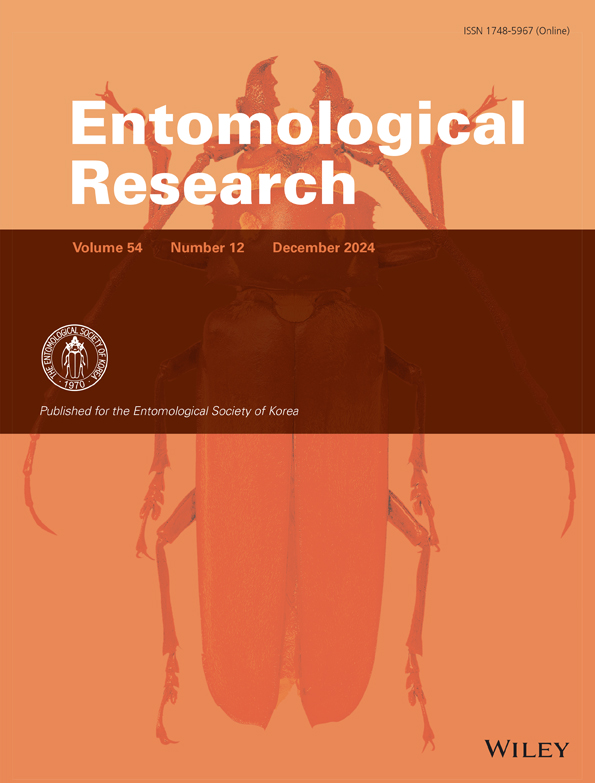Development of optimized artificial diets for enhanced growth of Zophobas atratus larvae
Funding information: This research activity was supported by the 'Research Program for Agriculture Science and Technology Development’ (Grant No. PJ01267002), National Institute of Agricultural sciences, Rural Development Administration, Republic of Korea.
Min Ji Park, First authors
Abstract
This study evaluates the effects of various artificial diets on the development of Zophobas atratus larvae. Artificial diets containing various concentrations of agar were also investigated for their ability to reduce death rates during the early stages of larval development. Our results indicated that larvae fed artificial diets experienced a slightly longer developmental period but achieved significantly higher weights. Notably, wheat bran + fish meal 6% resulted in the highest weight gain; however, wheat bran + fish meal 6%, wheat bran + fish meal 5% + ginseng leaf 1%, and wheat bran + fish meal 4% + ginseng leaf 2% yielded higher death rates. The diet with 4% agar resulted in the shortest developmental period, whereas that with 3% agar produced the highest weight gain. However, considering death rates, the diet with 2% agar provided the most balanced outcome across developmental time, weight gain, and survival, making it the most suitable diet for Z. atratus larvae. In conclusion, wheat bran + fish meal + agar 2% artificial diet is more suitable for Z. atratus larval development than wheat bran, leading to greater weight gain, shorter development periods, and higher adult emergence rates. Additionally, this diet showed the potential to reduce the dust issues and labor demands associated with wheat bran usage. Our findings suggest that wheat bran + fish meal + agar 2% could be an effective artificial diet for the optimal development of Z. atratus larvae.
Introduction
Insects have been a part of diets in many regions worldwide for centuries (Aidoo et al., 2023). The edible insect industry is experiencing rapid growth in the global market. Edible insects have recently gained attention as a promising food source (Aidoo et al., 2023; Patel et al., 2019; Rumpold & Schlüter, 2013). This interest is driven by the rich nutritional profile of edible insects, which includes high-quality proteins, vitamins, minerals, and other nutritional benefits, as well as their economic and environmental advantages (Kewuyemi et al., 2020; Mabelebele et al., 2023; Rumpold & Schlüter, 2013; Yates-Doerr, 2015).
This growing interest represents a significant shift in attitudes toward insect-based foods (Alston et al., 2009; Naseem et al., 2021). Edible insects are increasingly recognized as a promising solution to global food security challenges owing to their abundance, high protein content, and high nutrient density (Aidoo et al., 2023; Lange & Nakamura, 2023). Furthermore, their cultivation requires significantly fewer resources than traditional livestock, making them an appealing option from both economic and environmental perspectives (Godfray et al., 2010; Patel et al., 2019).
Zophobas atratus, commonly known as the giant mealworm, is a holometabolous insect belonging to the family Tenebrionidae of the order Coleoptera. Native to the tropical regions of Central and South America, this species has been introduced worldwide. Z. atratus is significantly larger than Tenebrio molitor and has a higher nutritional value (Park et al., 2013). The larvae of Z. atratus can be used as feed for rodents, reptiles, birds, pets, and other cultured species (Benzertiha et al., 2020; Hopley, 2016; Rumbos & Athanassiou, 2021). Moreover, Z. atratus has been recognized as a food source in Belgium since 2013 and was temporarily approved as an edible insect in South Korea in 2020 (Kim et al., 2020), before being converted to a general food source in 2022. It is widely consumed in several countries (Adámková et al., 2016; Bednárová et al., 2013; Kulma et al., 2020; Soares Araújo et al., 2019).
Recent studies comparing the nutritional components and harmful substances in Z. atratus larvae before and after defatting have shown that defatted larvae possess superior nutritional qualities and are free from harmful substances (Kim et al., 2019). The safety of defatted Z. atratus larval powder has been confirmed through subchronic toxicity tests in rodents (Kim et al., 2020, 2021). Additionally, T. molitor larvae reared on spent brewer's grains exhibited comparable growth and superior nutritional qualities compared to those reared on wheat bran (Kim et al., 2016). Furthermore, previous studies have assessed the potential of oil extracted from Z. atratus larvae as a new source of lipids (Sete da Cruz et al., 2022). Ongoing research is investigating the physicochemical properties of the chitin and chitosan extracted from these larvae (Shin et al., 2019; Soon et al., 2018). Zophobacin-1, a compound with antibacterial and anti-inflammatory activities, has been identified through the genomic analysis of Z. atratus, with increasing interest in the bioactive substances of this insect (Shin et al., 2020).
Genomic analysis, DNA barcoding, and the development of machine learning models utilizing image data are advancing research on the industrial traits of Z. atratus larvae (Kaur et al., 2023; Park et al., 2013; Pratondo & Bramantoro, 2022). Studies have shown that the nutritional value of Z. atratus varies according to its developmental stage, rearing techniques, and diet (Kouřimská & Adámková, 2016; Kulma et al., 2020). Z. atratus can grow up to 5 cm in length and is known as the “superworm” due to its high fat and phosphorus content, making it a promising new income source for farmers (Soares Araújo et al., 2019). The larvae have been identified as a viable food resource capable of meeting dietary requirements (Food and Agriculture Organization of the United Nations, 2010). Research has emphasized the importance of optimizing rearing techniques to obtain high-quality nutritional biomass (Cerritos, 2009; Van Huis, 2013). As the importance of securing and utilizing insect resources has increased, research on the development of artificial diets for the mass rearing of various insects has been actively conducted. In particular, the development of artificial breeding methods is essential to utilize Z. atratus as a food source or for medicinal applications (Dragojlović et al., 2022). However, wheat bran, which is currently the primary substrate used in Z. atratus rearing, generates dust, causing difficulties for breeders and increasing labor requirements (Ehlers et al., 1993; Ganseman et al., 2023; Neitzel et al., 2014). Moreover, the recent increase in grain prices has escalated feed costs, posing significant challenges for large-scale production (Javed et al., 2012; Prückler et al., 2014). The use of various protein sources, particularly fishmeal, in the rearing of edible insects has economic benefits (Food and Agriculture Organization of the United Nations, 2013). In addition, research on artificial diets for insects of the family Tenebrionidae is limited, and no specific artificial diet has been developed for Z. atratus (Anderson & Leppla, 1992; Cohen, 2001; Grenier, 2012). Therefore, there is an urgent need to develop optimized artificial diets that maximize rearing efficiency. Research on other insects has shown that artificial diets for indoor rearing can be highly successful, as evidenced by the silkworm, the most industrialized insect, Bombyx mori (Bhattacharyya, 2016; Cappellozza et al., 2005; Dong et al., 2017; Hiratsuka, 1967; Horie, 1995).
For silkworms, artificial diet production and supply systems have been widely disseminated to farms, thereby achieving practical success. Additionally, artificial diet research has been actively conducted on various insects, including Apriona germari, Matsumuraeses phaseoli, Maruca vitrata, Ascotis selenaria, and Mythimna loreyi (Choi et al., 2011; Jung et al., 2007; Kim et al., 2022; Yoon et al., 1997). However, research on artificial diets for Z. atratus remains insufficient. This study aims to address this gap by developing an artificial diet suitable for the large-scale rearing of Z. atratus. We investigated the growth characteristics and feed efficiency of Z. atratus using various types of artificial diets and agar concentrations. Accordingly, we aimed to provide foundational data for systematic edible insect management and a continuous supply of experimental insects. Finally, this study seeks to explore the potential for establishing a suitable artificial rearing system for the large-scale production of Z. atratus.
Materials and Methods
Selecting the Optimal Diet for Z. atratus Larvae among Artificial Diets
Preparation of Artificial Diets
The artificial diet (excluding multivitamins) was comprised of wheat bran, fish meal, ginseng leaf powder, sorbic acid, methyl-p-hydroxybenzoate, cooking oil, agar, and distilled water. To select the most suitable main ingredient for rearing Z. atratus, four types of artificial diets were prepared (Table 1). The artificial diets were as follows: 1) control (wheat bran), 2) wheat bran + fish meal 2% (WF2), 3) wheat bran + fish meal 6% (WF6), 4) wheat bran + fish meal 5% + ginseng 1% (WFG1), and 5) wheat bran + fish meal 4% + ginseng 2% (WFG2). To determine the most suitable agar concentration, diets were prepared based on wheat bran and fish meal as the primary ingredients, with varying agar contents (Table 2). The agar ratio experiment was designed with the following treatments: 1) control (wheat bran), 2) wheat bran + fish meal 2% + agar 1% (WFA1), 3) wheat bran + fish meal 2% + agar 2% (WFA2), 4) wheat bran + fish meal 2% + agar 3% (WFA3), and 5) wheat bran + fish meal 2% + agar 4% (WFA4).
| Artificial diets composition (%) | WF2 | WF6 | WFG1 | WFG2 | Control |
|---|---|---|---|---|---|
| Wheat bran | 18 | 14 | 14 | 14 | 100 |
| Fish meal | 2 | 6 | 5 | 4 | |
| Ginseng leaf powder | - | - | 1 | 2 | |
| Agar | 1 | 1 | 1 | 1 | |
| Distilled water | 79 | 79 | 79 | 79 |
- Note: WF2, wheat bran + fish meal 2%; WF6, wheat bran + fish meal 6%; WFG1, wheat bran + fish meal 5% + ginseng leaf powder 1%; and WFG2, wheat bran + fish meal 4% + ginseng leaf powder 2%. All artificial diets were supplemented with 0.04% Sorbic acid, 0.04% methyl-p-hydroxybenzoate, 0.4% edible oil, and 2% multiple vitamins.
| Artificial diets composition (%) | WFA1 | WFA2 | WFA3 | WFA4 | Control |
|---|---|---|---|---|---|
| Wheat bran | 18 | 18 | 18 | 18 | 100 |
| Fish meal | 2 | 2 | 2 | 2 | |
| Agar | 1 | 2 | 3 | 4 | |
| Distilled water | 79 | 79 | 79 | 79 |
- Note: WFA1, wheat bran + fish meal + agar 1%; WFA2, wheat bran + fish meal + agar 2%; WFA3, wheat bran + fish meal + agar 3%; and WFG2, wheat bran + fish meal + agar 4%. All artificial diets were supplemented with 0.04% Sorbic acid, 0.04% methyl-p-hydroxybenzoate, 0.4% edible oil, and 2% multiple vitamins.
Artificial Diet Processing and Handling
The artificial diet ingredients were thoroughly mixed in the specified ratios and placed in a metal container (17 cm in length × 11 cm in width × 4 cm in height). The container was covered with parafilm, sealed with a lid, and then steamed in an autoclave (Tomy Kogyo Co., LTD, Tokyo, Japan) at 100–110 °C for 10–20 min. After sterilization, the artificial diet was removed and mixed evenly with the multivitamins dissolved in 70% ethanol. The diet was then pressed flat, allowed to cool at room temperature, and stored in a refrigerator at 5 °C until use. Prior to feeding, the prepared diet was cut into appropriate sizes according to the larval instar stage (Fig. 1).
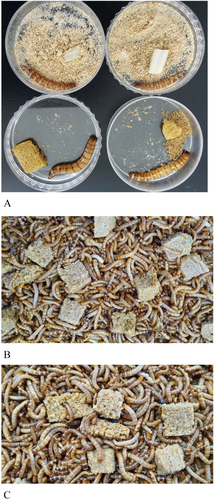
Experimental Insects and Rearing
To investigate the developmental characteristics of Z. atratus larvae fed different types of artificial diets, eggs from the fifteenth generation of Z. atratus, obtained from the National Institute of Agricultural Sciences, were used in the experiment. The eggs were laid within one day under conditions of 30 °C, 65% relative humidity, and a 9 L:15 D photoperiod (Kwak et al., 2022).
Development Characteristics of Z. atratus Larvae
Developmental Characteristics According to the Types of Artificial Diets
The developmental characteristics of Z. atratus were investigated using various artificial diets. The artificial diets were as follows: control, WF2, WF6, WFG1, and WFG2. Rearing was conducted in the Industrial Insect and Sericulture Division laboratory at the National Institute of Agricultural Sciences, under controlled conditions in a constant temperature and humidity chamber (Dasol Scientific, Hwaseong, Korea) at 30 °C, 65% relative humidity, a 9 L:15 D photoperiod, and an illumination intensity of 1800 lux. Forty newly hatched larvae per treatment group were reared individually (one larva per Petri dish) and observed for larval weight, death rate, and developmental period.
Developmental Characteristics based on Agar Ratios in Artificial Diets
The developmental characteristics of Z. atratus were assessed based on the agar ratios in artificial diets. The agar ratio experiment was performed using the following treatments: control, WFA1, WFA2, WFA3, and WFA4. The rearing conditions were identical to those described previously.
Comparison of Developmental Characteristics between Selected Artificial Diets and Wheat Bran
The developmental characteristics of Z. atratus were compared between the selected artificial diets (WFA2) and wheat bran (control). The rearing conditions were identical to those described previously.
Investigation of Food Efficiency in Artificial Diets compared to Wheat Bran
The food efficiency of Z. atratus was compared between the selected artificial diets (WFA2) and wheat bran (control). Ten newly hatched larvae were reared individually (one larva per Petri dish) per treatment, with three replicates per treatment. The observations were performed once daily. The weights of the ten larvae were measured and averaged to calculate individual larval weights. For the artificial diet, the amount of food consumed was adjusted by accounting for moisture evaporation. The rearing conditions were maintained at 30 °C, 65% relative humidity, a 9 L:15 D photoperiod, and 1800 lux. The collected data included individual larval weights, food consumption per larva, and food conversion efficiency (ECD) at various developmental stages.
Statistical Analysis
A one-way analysis of variance (ANOVA) was conducted to assess differences in larval weight and developmental period across the various types of artificial diets. The Chi-square test was used to assess differences in larval death rates across the various artificial diets, as well as to evaluate the timing of the transition to prepupal stages and emergence rates. A t-test was utilized to compare the duration of the transition to prepupal stages and the duration from the first instar to emergence. All statistical analyses were performed using the statistical package SPSS PASW 22.0 for Windows (IBM, Chicago, USA).
Results
Selection of Optimal Artificial Diets based on the Developmental Characteristics of Z. atratus Larvae
The developmental characteristics of Z. atratus were investigated using wheat bran as a control and compared with four artificial diets: WF2, WF6, WFG1, and WFG2 (Fig. 2). We found that the developmental duration from the first to fifth instar was slightly longer for all four artificial diets than for the control (Fig. 2(A)). Specifically, the developmental duration for WF6 was 53.4 ± 7.5 d, while for WF2 it was 53.9 ± 7.4 d, both of which were 0.3–0.8 d longer than that of the control group, wheat bran (53.1 ± 5.0 d) (Fig. 2(B)). In contrast, the developmental periods for WFG1 (58.3 ± 7.0 d) and WFG2 (55.9 ± 6.2 d), both containing ginseng leaf powder, were 2.8 to 5.2 d longer than that of the control. Regarding body weight at the tenth instar, larvae fed any of the four artificial diets — WF2 (58.7 ± 43.4 mg), WF6 (74.9 ± 57.1 mg), WFG1 (72.9 ± 65.4 mg), and WFG2 (46.6 ± 20.8 mg) — were significantly heavier, weighing 1.8–2.9 times that of the control group (26.1 ± 12.3 mg) (p = 0.0001) (Fig. 2(C)).
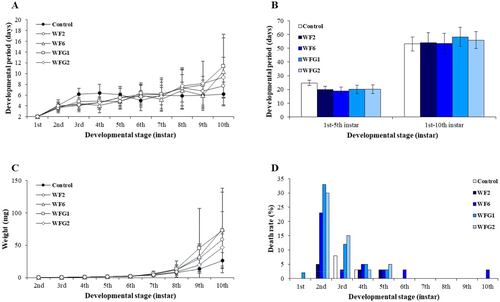
Among the four artificial diets, WF6 resulted in the greatest increase in body weight (2.9-fold increase compared to that of the control), followed by WFG1 (2.8-fold increase), WF2 (2.3-fold increase), and WFG2 (1.8-fold increase). A comparison of death rates up to the tenth instar revealed that while the control and WF2 both exhibited a death rate of 10%, the rates for WF6, WFG1, and WFG2 were significantly higher at 38%, 55%, and 53%, respectively, representing a 28–45% increase compared to that of the control (Fig. 2(D)).
Selection of Agar Ratio-based Artificial Diets according to the Developmental Characteristics of Z. atratus Larvae
To reduce the death rate of Z. atratus larvae, particularly during the early instars, we investigated the developmental characteristics of four artificial diets with varying agar concentrations (WFA1, WFA2, WFA3, and WFA4) (Fig. 3). The results showed that WFA4 produced the shortest developmental duration from the first to the tenth instar, averaging 48.8 ± 5.8 d (Fig. 3(B)). This was followed by WFA3 (50.2 ± 4.9 d), WFA2 (51.0 ± 4.9 d), and WFA1 (52.6 ± 5.0 d). The artificial diets with varying agar concentrations resulted in developmental periods that were 0.6–4.4 d shorter than those of the control (wheat bran, 53.2 ± 5.0 d) at both the fourteenth instar (p = 0.036) and the tenth instar (p = 0.055). In terms of body weight, the artificial diets with varying agar concentrations resulted in heavier larvae compared to those of the control (wheat bran). At the fourteenth instar, larvae fed with these diets were 1.2- to 1.6-fold heavier than those in the control group (209.3 ± 145.7 mg) (p = 0.037) (Fig. 3(C)). Among the four artificial diets with varying agar concentrations, WFA3 yielded the highest weight (320.4 ± 164.5 mg), representing a 1.53-fold increase compared to the weight of the control group. This was followed by WFA2 (1.16-fold increase), WFA4 (1.14-fold increase), and WFA1 (1.14-fold increase). A comparison of death rates up to the fourteenth instar revealed that while the control and WFA2 had death rates of 20.0% and 23.3%, respectively, WFA1 had the highest death rate at 46.7% (Fig. 3(D)). This was followed by WFA3 (43.3%) and WFA4 (33.3%), both of which had 3.3- to 26.7-fold higher death rates than that of the control.
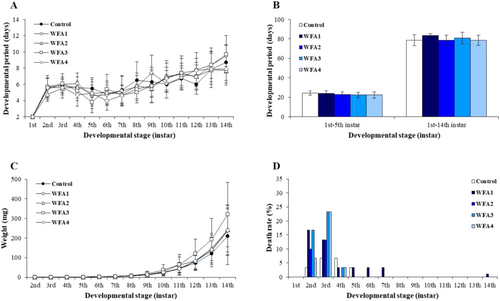
Evaluating the Selected Artificial Diet Compared to Wheat Bran based on Larval Development
We investigated the developmental characteristics of Z. atratus larvae fed with WFA2, identified as the most suitable artificial diet, and compared them with the larvae fed with wheat bran as a control (Fig. 4). The developmental duration from the first to the fifteenth instar was slightly shorter for the artificial diet WFA2 (86.6 ± 6.5 d) compared to the control (wheat bran, 92.1 ± 6.4 d); however, this difference was not statistically significant (p = 0.109) (Fig. 4(B)). Body weight differences between larvae fed the artificial diet and those fed wheat bran were negligible until the fifth instar. However, from the sixth instar onward, larvae fed with the artificial diet were significantly heavier (Fig. 4(C)). By the tenth instar, the larvae fed by the artificial diet were approximately two-fold heavier than those fed by the control diet. As the larvae approached the pupation stage, this difference decreased by 1.7- to 1.2-fold compared to the control weight. Death rates up to the twelfth instar did not differ significantly between the artificial diet and control, both exhibiting a rate of 7.5% (Fig. 4(D)).
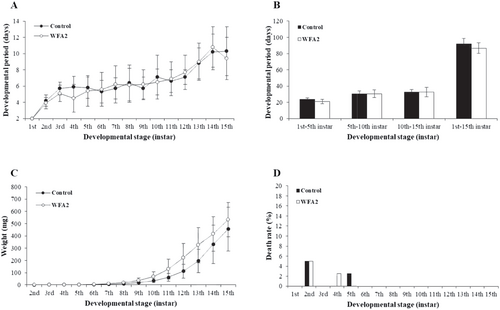
Larvae on the artificial diet began pupation at the twelfth to thirteenth instar, whereas those fed wheat bran began pupation at the fourteenth instar, suggesting a trend of delayed development with the control diet (Fig. 5). At the 105-day mark, 83.8% of the larvae fed by the artificial diet reached the pupation stage, compared to 59.5% in the control group fed by wheat bran (p = 0.020), representing a 24.3% increase (Fig. 5(A)). The emergence rate of adults was also higher in the artificial diet group, with a rate of 30%, compared to 20% in the wheat bran group (p = 0.0001). The pupation duration for larvae fed with the artificial diet was 17.2 ± 4.0 d, which was 1.2 d longer than for those fed wheat bran (Fig. 5(B)). However, the total developmental duration from the first instar to the adult stage for larvae fed by the artificial diet was approximately 4 d shorter than that for larvae fed wheat bran (Fig. 6).

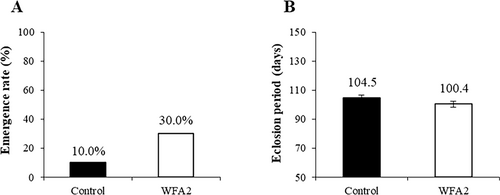
Food Efficiency of Artificial Diet and Wheat Bran for Z. atratus
To evaluate the food efficiency of the artificial diet (WFA2) compared to that of wheat bran for Z. atratus, we measured the weight per larva (Fig. 7(A)). The results showed that from the seventh instar onward, larvae fed the artificial diet were nearly twice as heavy as those fed wheat bran. Although food consumption per larva was higher with the artificial diet up to the eighth instar, from the ninth instar onward, larvae fed wheat bran consumed more feed (Fig. 7(B)). A food efficiency analysis at different developmental stages revealed that the artificial diet had lower food efficiency than wheat bran up to the sixth instar but demonstrated higher efficiency from the eighth instar onward (Fig. 7(C)).
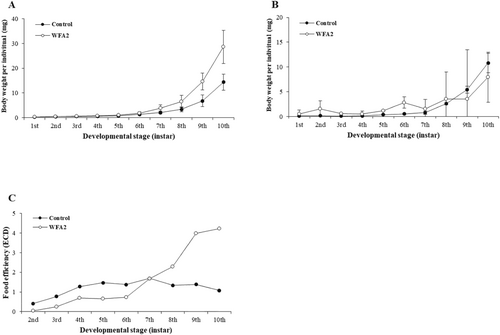
Discussion
There has been extensive global research on insect diets, and although the rearing of Z. atratus has significantly increased, there is still no standardized artificial diet for this species. To support large-scale production, it is essential to establish an artificial diet that meets the nutritional requirements of Z. atratus larvae. Previous studies have investigated the developmental characteristics of Z. atratus larvae reared on wheat bran at different temperatures, offering insights into the growth patterns of the species (Kwak et al., 2022). Based on these established developmental conditions, we conducted indoor rearing experiments to optimize artificial diets for Z. atratus. However, further research is crucial to optimize artificial diets, which drove the purpose of this study.
In developing an artificial diet for Z. atratus, fish meal was selected as the primary protein source. Fish meal is widely used in the feed industry as a key protein source owing to its high protein content and excellent amino acid profile. Additionally, its low carbohydrate content and high digestibility make it a valuable nutritional resource for insect diets (Cho & Kim, 2010; Miles & Chapman, 2006; Shepherd & Jackson, 2013; Zhou et al., 2004). Overall, the artificial diets WF2, WF6, WFG1, and WFG2, which included fishmeal and ginseng leaf powder, led to better larval development than the wheat bran (control diet). This improvement is likely attributed to the nutritional benefits of fishmeal. The high protein content and essential amino acids in fishmeal played a significant role in promoting larval growth. Interestingly, a previous study demonstrated that the addition of Moringa leaves to artificial diets for T. molitor increased their nutritional value (Kotsou et al., 2023). However, when ginseng leaf powder was incorporated into artificial diets for Z. atratus, the results were less favorable.
Although the addition of ginseng leaf powder to the diets (WFG1 and WFG2) increased larval body weight, it also extended the developmental period and resulted in higher death rates. This suggests that ginseng leaf powder, although beneficial for weight gain, introduces trade-offs that render it unsuitable for efficiently rearing Z. atratus. These results suggest that certain dietary components may cause trade-offs between growth performance and overall survival. Due to the particularly high death rate during the early larval stages, we adjusted the agar concentration in the artificial diets to determine its effects on larval survival and development. WFA2, which avoids these trade-offs and includes a specific agar concentration that enhances overall growth, was the most suitable artificial diet for Z. atratus.
This study demonstrated that the WFA2 artificial diet was more effective than wheat bran for the development of Z. atratus larvae, significantly improving larval weight gain, reducing developmental duration, and enhancing adult emergence rates. Our findings indicate that WFA2 is a highly effective diet for artificially rearing Z. atratus, which may be advantageous for large-scale production. However, the food efficiency of WFA2 during the early developmental stages remained suboptimal, as observed by its lower efficiency compared to that of wheat bran until the eighth instar. This discrepancy suggests the necessity for a more in-depth analysis of the nutritional composition and larval metabolic requirements during the early instars, potentially guiding future modifications to the diet formulations. Nonetheless, after the eighth instar, WFA2 exhibited superior efficiency, indicating that it is especially advantageous during the later stages of development. Additionally, while WFA2 reduces delays in development and offers a promising solution for industrial applications, the factors contributing to the pupation delays observed in this study should be explored.
Understanding the biochemical or hormonal triggers that influence pupation timing could facilitate further refinement of the diet's composition and optimize the transition from larval to adult stages, thereby ensuring consistent developmental timelines in mass-rearing conditions. Furthermore, the development of artificial diets, such as WFA2, mitigates issues related to dust generation and reduces the labor demands typically associated with wheat bran substrates. Consequently, the use of WFA2 enhances the overall efficiency of rearing Z. atratus by reducing the need for frequent substrate changes and improving substrate hygiene.
Future research should focus on the systematic evaluation of various artificial diets, including WFA2, to optimize the rearing and mass production of Z. atratus. Therefore, a thorough assessment of diet composition and its effects on developmental parameters is essential to ensure sustainable and efficient large-scale insect farming. Moreover, customizing diet formulations to cater to different larval growth stages may enhance both the early and late developmental phases. Expanding research to include comparative trials with other promising artificial diets will further contribute to the development of cost-effective, nutritionally balanced, and sustainable diets for the large-scale production of Z. atratus and other economically crucial insects.
Acknowledgments
This research activity was supported by the ‘Research Program for Agriculture Science and Technology Development’ (Grant No. PJ01267002), National Institute of Agricultural sciences, Rural Development Administration, Republic of Korea.
Open Research
Data Availability Statement
Research data are not shared.



